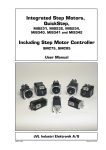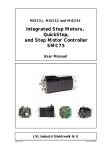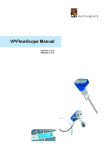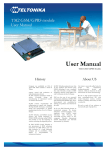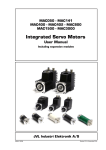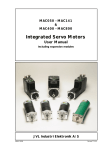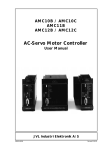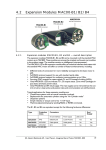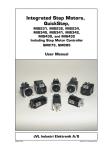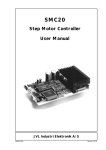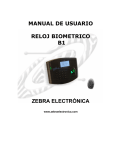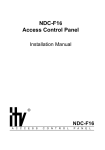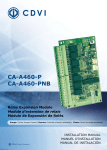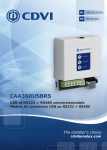Download User Manual
Transcript
11.2 Step motor controllers (SMCxx) SMC75 SMC75 mounted in a housing The compact step motor controller SMC75 is designed for positioning and speed control of stepper motors. SMC75 is a PCB with di- mensions 57x57mm and mounted with SMD electronics on both sides. It is mounted directly in the housing of the JVL QuickStep motors MIS 231, 232 and 234, forming a complete integrated step motor. It may also be used with other types of step motors according to customers requirements. The basic features of the controller are: • Serial RS485 or 5V serial position controller • Position controller with graphic programming. • Option for CANbus, CANopen DS-301/ DSP-402 or DeviceNet (under development). • A dual supply facility is available so that position and parameters are maintained at emergency stop • Gear mode • MACmotor protocol so MACmotor and Quickstep motors can be connected on the same RS485 bus • Command for easy PLC/PC setup and communication • Power supply 12-48VDC • Fixed 1600 pulses/rev. • Built-in µprocessor with 8 In/Out that can be configured as inputs, PNP outputs or analogue inputs. 5V serial and RS485 interface for set up and programming. • MODBUS interface. • 9.6 to 1Mb communication 248 • Driver technology is improved as compared to SMD73 and supply voltage is 12-48VDC (Control voltage 1228VDC). When used with the QuickStep motor or mounted on any other step motor the advantages of the controller are: • De-central intelligence. • Simple installation. No cables between motor and driver. • EMC safe. Switching noise remains within motor. • Compact. Does not take space in cabinet. • Low-cost alternative to separate step or servo motor and driver. • Stall detect by means of magnetic encoder with resolution of up to 1024 pulses/rev. • Interface possibilities to the SMC75 controller: • From PC/PLC with serial commands via 5V serial or RS485. • Pulse/direction input. Encoder output. • CANopen, DeviceNet • 8 I/O, 5-28VDC that can be configured as Inputs, Outputs or analogue inputs • Future option for Profibus DP, Ethernet, Bluetooth and Zigbee wireless JVL Industri Elektronik A/S - User Manual - Integrated Stepper Motors MIS23x, 34x, 43x 11.2 Block diagram, Positioning/Speed Control User I/O connector Power supply connector Main supply Serial interface connector Field Bus connector Motor SMC75 or SMC85 Controller P+ 12-48V (SMC75) P+ 12-80V (SMC85) CVI 1/8 step Phase A Driver 1600 step/rev. Switchmode Power Supply 12-28V logic P- (Ground) 2-phase stepper motor Phase B Fuse 750mA CVO IO1 Output source driver 16Bit (SMC75) 32Bit (SMC85) Microprocessor with Integrated Flash IO8 IN1 Analog 1 Digital 1 Tx IN8 Analog 8 Digital 8 High speed digital logic array Rx A- RS485 driver B+ 1024 ppr magnetic incremental encoder CAN R CAN Tranciever Optional CAN L Encoder Optional Multifunction I/O Interface 11.2.1 Step motor controllers (SMCxx) A+ AB+ B- RS422 Optional JVL Industri Elektronik A/S - User Manual - Integrated Stepper Motors MIS23x, 34x, 43x TT2140GB 249 11.2 Step motor controllers (SMCxx) Step Motor Controller SMC75 is a mini-step driver with fixed 1600 pulses/rev., which has been designed for driving step motors with phase currents of up to 3 Amp/phase (RMS). The Controller SMC75 is available in 2 different versions for various applications. It is built into the QuickStep Integrated Step Motors, but for OEM and low-cost applications it can be delivered as a PCB or in its own housing with M12 connectors. For easy mounting and service, the version with M12 connectors is recommended. A version with cable glands can be used for high volume and low cost applications. Order no. PCB SMC75A1 X SMC75A1AC X BOX CANopen IO X SMC75A1M3 X SMC75A1W0 1 8 1 8 X SMC75A1M6 8 4 X SMC75A1M5 RS485 X X 8 8 2 1 1 M12 Cable Glands X X X 1 X Other combinations and features are also possible for OEM use. See “Connector overview for the MIS23x” on page 32. for further information. The “box” version which is built into a black aluminium casing provides a very robust construction that is insensitive to mechanical vibration and electrical noise. The advantage of using a ministep driver instead of a conventional full-step or half-step driver is that mechanical resonance problems are significantly minimised. Resonance most often occurs at slow motor speeds and results either in loss of motor torque or the appearance of significant harmonics. The principle of the ministep technique is to drive the motor using a sinusoidal current in the interval between 2 physical full steps. This reduces the step velocity between each step and thus damps any resonance significantly. Comparison between ministep and full step Current (%) 150 Ministep Full step 100 Resonance during full step operation Position (Full steps) 6 Overshoot 5 50 4 0 3 -50 2 -100 -150 1 1 2 3 Position 4 (Full steps) 0 TT2158GB Time Both 2-phase and 4-phase step motors can be connected to the Controller, which utilises the “Bipolar Chopper” principle of operation, thus giving optimum motor performance. 250 JVL Industri Elektronik A/S - User Manual - Integrated Stepper Motors MIS23x, 34x, 43x 11.2 11.2.2 Step motor controllers (SMCxx) SMC75 Connector overview The connections to the various connectors of the SMC75 PCB board is shown below. Note that GND and P- are connected together internally. J4 J3 IO1 User IO IO2 IO3 IO4 CVO ARS485 (Communication) B+ GND Ground Rx RS232 (5V) Tx (optional) 1 2 3 4 5 6 7 8 9 10 Recommended connectors Molex (or equivalent from CViLux) Crimp contact 50079-8000 x 10 Housing 10 pin 51021-1000 x 1 or CViLux Crimp contact CI44T011PEO x 10 Housing 10 pin CI4410 S000 x 1 IO5 IO6 User IO RS422 (Multifunction I/O) Ground RS422 (Multifunction I/O) IO7 IO8 CVO B1+ B1GND A1+ A1- SMC75 Circuitboard 1 2 3 4 5 6 7 8 9 10 J1 - "Generation 2" connector J5 J2 1 P+ (Main power) CAN_H CAN_L (Optional) V+ CAN 1 2 3 4 5 6 2 CVI (Control voltage input) 3 P(Main ground) GND TT2152-02GB Recommended connectors Molex (or equivalent from CViLux) Crimp contact 50079-8000 x 6 Housing 6 pin 51021-0600 x 1 CViLux Crimp contact CI44T011PEO x 6 Housing 6 pin CI4406 S000 x 1 Recommended connector Housing: Crimp terminals: Molex 08-50-106 Molex 09-91-0300 Pitch = 3.96mm (Nylon UL94V-0) The figure below shows the generation 2 connector for future or special purposes. Please contact JVL for further information. JVL Industri Elektronik A/S - User Manual - Integrated Stepper Motors MIS23x, 34x, 43x 251 11.3 How to connect the motor Only SMCxx BB+ Screen Step Motor AGround A+ Terminate screen only at SMC75 TT2168GB 11.3.1 Cabling For SMC75 controllers that supply a phase current in the range 0 to 3 A, it is recommended that 0.5mm² cable (minimum) is used to connect the motor to the controller. (0.75mm² is recommended.) Motor cable lengths should not exceed 10 metres because of impedance loss. It is possible to use longer cables but motor performance will decrease. Cables should be securely connected since a poor connection can cause heating and destruction of the connector. Similarly, tinned conductors should be avoided. Important! To minimise spurious noise emission from the motor cables and to fulfil CE requirements, shielded cable must be used. If shielded cable is not used, other electronic equipment in the vicinity may be adversely affected. The removable connector must never be removed while a voltage is connected as this will significantly reduce the lifetime of the connector. Note also that the connector’s lifetime is reduced by repeated connecting/disconnecting since the contact resistance of the pins is increased. Note that P- is connected to the chassis and functions as the main ground on the Controller. See also Motor Connections Section 15.6, page 303, which describes how various models of motor should be connected to the Controller. 252 JVL Industri Elektronik A/S - User Manual - Integrated Stepper Motors MIS23x, 34x, 43x 11.3 How to connect the motor Serial connection of phases: Motor Torque A+ SMC75 Parallel A- Serial B+ Velocity Current for Serial or Parallel connection B- Maximum current settting Example motor 4.2A Motor 4-phase parallel I x 1.41 4.2 x 1.41 =5.9 Motor 4-phase serial I 1.41 4.2 = 3A 1.41 Motor 2-phase I 4.2A SMC75 Parallel connection of phases: I = Nominal current per phase in accordance with manufacturer's specifications 11.3.2 TT2207GB Connection of Step Motor Various types of step motor are available: 1. 2-phase Bipolar (4 connectors) 2. 4-phase Bipolar/Unipolar (8 connectors) 3. 4-phase Unipolar (6 connectors). Note that Type 3 motors indicated above (Unipolar motors) produce 40% less torque. This motor type can be used with success but is not recommended if a 4 or 8 wire motor is available instead. This section will not describe the unipolar type further. 2-phase or 4-phase motors can be connected to the Controllers as follows: 2-phase Motors (4 wires). This type of motor can be directly connected to the Controller’s motor terminals. The Controller current adjustment must not exceed the manufacturer’s specified rated current for the motor. 4-phase Motors (8 wires). This type of motor can be connected to the Driver in one of the following two ways: 1. Serial connection of phases. 2. Parallel connection of phases. Selection of serial or parallel connection of the motor phases is typically determined by the speed requirements of the actual system. If slow speeds are required (typically less than 1 kHz), the motor phases can be connected in serial. For operation at higher speeds (greater than 1 kHz), the motor phases can be connected in parallel. JVL Industri Elektronik A/S - User Manual - Integrated Stepper Motors MIS23x, 34x, 43x 253 11.3 How to connect the motor 11.3.3 Serial Connection Using serial connection of the phases, a motor provides the same performance (up to 1kHz) as parallel connection, but using only approximately half the current. This can influence the selection of Controller model and enables a Controller rated for a lower motor current to be used. See illustration on previous page. If the phases of a 4-phase step motor are connected in series, the motor’s rated phase current should be divided by 1.41. For example, if the rated current is 4.2A, the maximum setting of the Controller phase current must not exceed 3 A when the motor phases are connected in series. 11.3.4 Parallel Connection With parallel connection of motor phases, a motor will provide better performance at frequencies greater than 1kHz compared to serially connected phases, but requires approximately twice the current. This can influence the choice of Controller since it is necessary to select a Controller that can supply twice the current used for serial phase connection. See illustration on previous page. When the phases of a 4-phase motor are connected in parallel, the specified rated current of the motor must be multiplied by a factor of 1.41. For example, if the rated current is 2.0A, the maximum setting of the Controller phase current must not exceed 2.83A when the phases are connected in parallel. It should be noted that the lower the self-induction of the motor the better, since this influences the torque at high speeds. The torque is proportional to the current supplied to the motor. The applied voltage is regulated by the Controller so that the phase current is adjusted to the selected value. In practice this means that if a motor with a large self-inductance (e.g. 100mH) is used, the Controller cannot supply the required phase current at high speeds (high rotational frequencies) since the output voltage is limited. 254 JVL Industri Elektronik A/S - User Manual - Integrated Stepper Motors MIS23x, 34x, 43x 11.4 11.4.1 How to connect in general MIS23x: M12 connections M12 connectors 1 2 2 1 5 5 4 3 3 1 2 8 7 6 5 4 2 3 1 7 3 4 4 6 5 TT2143GB Example of SMC75 controller connections. 2 5 1 3 4 PWR I/O5-8 PWR: RS485 5 pin male RS485: 5 pin female I/O1-4: 8 pin female I/O1-4 RS485 I/O5-8: 8pin female TT2205GB 5- pole connector 8-pole connector Pin no. Colour Pin no. Colour 1 Brown 1 White 2 White 2 Brown 3 Blue 3 Green 4 Black 4 Yellow 5 Grey 5 Grey 6 Pink 7 Blue 8 Red Colour code for standard cables JVL Industri Elektronik A/S - User Manual - Integrated Stepper Motors MIS23x, 34x, 43x 255 11.5 Quick Start (SMC75A1MxAA) 1 - A+ 2 - A3 - B+ 4 - B5 - NC 24-48VDC Step motor 24VDC brown white blue black grey red white blue yellow 11.5.1 1 1 2 3 3 4 5 5 2 4 5 5 2 3 4 1 RS485-USB-ATC-820 Cable RS485-M12-1-5-5 PC with USB input 2 8 (CVO) 3 1 (IO1) 5 1 8 4 7 (IO4) 4 (GND) 7 5 6 TT2169GB Getting started with the SMC75A1MxAA and MacTalk 1. Connect the cables and Power supply as shown above. Use RS485-M12-1-5-5 cable if the PC has an RS485 interface, or use the converter RS485-USB-ATC-820 if the PC has a USB interface. Please note that other models use an 8-pin female connector and therefore use RS485-M12-1-5-8 cable. 2. Switch on the SMC75. 3. Start MacTalk and wait 5 seconds until it automatically is connected to the motor. If “no connection” occurs, check the serial cables and the Mactalk set-up. The Baud rate should be 19200 and the correct com port selected. 4. When a connection has been established, key in values of “running current” and “standby current” under “Driver Parameters”. Remember to press “Enter” after each parameter is keyed in. Actual motor values can be seen to the left of the input field. 5. Set “Startup mode” to select “Position” to enable the motor driver. There should now be current in the motor phases. Depending on the standby current, the motor shaft will be fixed. Some current regulation noise should be heard from the motor. 6. The motor and I/O status can be seen to the left under “Status”. 7. At “Motion Parameter”, key in 1600 counts at “Position”. The motor will now turn one revolution at the speed specified by “Max Velocity”. 256 JVL Industri Elektronik A/S - User Manual - Integrated Stepper Motors MIS23x, 34x, 43x









